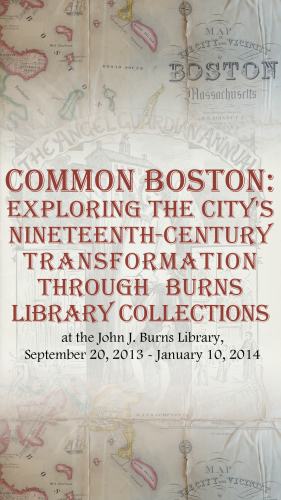IMMIGRATION, CRIME, SOCIAL WELFARE, CULTURE: how did nineteenth-century Bostonians shape and respond, alone and together, to the changing urban landscape? This exhibit explores personal and collective responses to a city swept first by immigrants, then by fire, forced to reinvent itself as a both physical and social space. On display are a selection of print and manuscript documents representing individual, institutional, and governmental responses to the challenges and opportunities presented by life in a dense, diverse, and growing city. The exhibit features diaries of 19th-century citizens, theatre broadsides and scrapbooks, the published reports of social service agencies concerned with health and welfare, records kept by the Boston Police Department, immigrant financial records, and images of the Great Fire of 1872.
Building the urban landscape – with bricks and mortar, and with services and organizations – left a documentary trail in libraries and archives throughout the region. Boston College, now celebrating its sesquicentennial, was collecting Boston material from its beginnings in the South End. The Burns Library historical Bostoniana collection also owes much to the generosity and foresight of two donors: Ellerton J. Brehaut (d. 1985), an avid collector and proud promoter of Boston who served at the Boston Chamber of Commerce from 1919 to 1959, witnessing enormous changes in the city, and John T. and Ruth M. Galvin, who established an endowment for the acquisition material documenting Boston political history.

